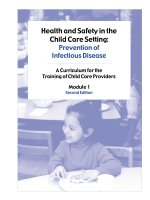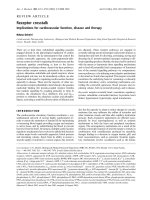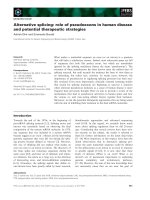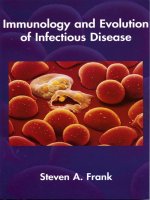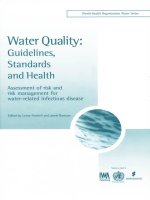Ch09 infectious disease and immunology (1)
Bạn đang xem bản rút gọn của tài liệu. Xem và tải ngay bản đầy đủ của tài liệu tại đây (8.79 MB, 141 trang )
Fundamental
Microbiology
CHAPTER 9
Introduction to Infectious disease
and Immunology
Normal Microbiota and the Host
• Loca&ons
of
normal
microbiota
on
and
in
the
human
body
-‐
Skin
and
mucous
-‐
Gastrointes&nal
tract
-‐
Urogenital
tract
• Microbes
that
engage
in
m u t u a l
o r
c o m m e n s a l
a s s o c i a & o n s
–
n o r m a l
(resident)
flora,
indigenous
flora,
microbiota
Includes
bacteria,
fungi,
protozoa
and
arthropods
Normal Microbiota and the Host
• Normal
microbiota
permanently
colonize
the
host
• Symbiosis
is
the
rela&onship
between
normal
microbiota
and
the
host
Normal Microbiota and the Host
• In
commensalism
(Hội
sinh),
one
organism
is
benefited
and
the
other
is
unaffected.
• In
mutualism
(hỗ
sinh),
both
organisms
benefit.
Exp.
Rumen
microbiota
• In
parasi
organism
is
benefited
at
the
expense
of
the
other.
Exp.
Enterobacteria
• Some
normal
microbiota
are
opportunis
pathogens
Exp.
E.
coli
What is a role of normal microbiota?
• Normal
microbiota
protect
the
host
by:
– occupying
niches
that
pathogens
might
occupy
– producing
acids
(lac&c
acid
bacteria
in
vagina
– producing
bacteriocins
Principles of Disease and
Epidemiology
• Pathology
Study
of
disease
• Pathogenesis
Development
of
disease
• Infec&on
Coloniza&on
of
the
body
by
pathogens
• Disease
An
abnormal
state
in
which
the
body
is
not
func&onally
normally
Infectious diseases
• Infec
a
condi&on
in
which
pathogenic
microbes
penetrate
host
defenses,
enter
&ssues
and
mul&ply
• Disease
–
An
abnormal
state
in
which
the
body
is
not
func&onally
normally
• Caused
by
microbes
or
their
products
–
infec
Reservoirs of Infection
• Reservoirs
of
infec&on
are
con&nual
sources
of
infec&on.
• Human
—
AIDS,
gonorrhea
• Carriers
may
have
inapparent
infec&ons
or
latent
diseases
• Animal
—
Rabies,
Lyme
disease
• Some
zoonoses
may
be
transmiTed
to
humans
• Nonliving
—
Botulism,
tetanus
• Soil
Koch's Postulates
Transmission of Disease
Contact
Direct
Indirect
Droplet
Requires
close
associa&on
between
infected
and
suscep&ble
host
Spread
by
fomites
Transmission
via
airborne
droplets
Transmission of Disease
Transmission of Disease
• Vehicle
Transmission
by
an
inanimate
reservoir
(food,
water)
• Vectors
Arthropods,
especially
fleas,
&cks,
and
mosquitoes
• Mechanical
Arthropod
carries
pathogen
on
feet
• Biological
Pathogen
reproduces
in
vector
Emerging Infectious Diseases
1
2
1+2
Living
condi&ons
Host
state
1+2+3
disease
1+3
2+3
Pathogenic
microorganism’s
source
3
Disease
triangle
Mechanisms of Pathogenicity
Portals of Entry
How
microorganisms
enter
a
host?
• Mucous
membranes
– Respiratory
tract
– Gastrointes&nal
tract
– Genitourinary
tract
– Conjunc&va
• Skin
– Tough
so
rare
-‐
Necator
americanus
-‐
hookworm
• Parenteral
route
– Puncture,
injec&on,
bites,
cuts,
wounds,
surgery,
etc
1st Portal of Entry: Mucous Membranes -Respiratory
• Respiratory
Tract
– microbes
inhaled
into
mouth
or
nose
in
droplets
of
moisture
or
dust
par9cles
– Easiest
and
most
frequently
traveled
portal
of
entry
•
Common cold
•
Flu
•
Tuberculosis
•
Whooping cough
•
Pneumonia
•
Measles
•
Strep Throat
•
Diphtheria
Mucous
membranes:
G.I.
Tract
• Salmonellosis
(ngộ
đọc
thực
phẩm)
– Salmonella
sp.
• Shigellosis
(lỵ)
– Shigella
sp.
• Cholera
– Vibrio
cholorea
Fecal - Oral Diseases
• Ulcers
(loét
dạ
dày)
• These pathogens enter the G.I. Tract at
– Helicobacter
pylori
one end and exit at the other end.
• Botulism
• Spread by contaminated hands & fingers
– Clostridium
botulinum
or contaminated food & water
• Poor personal hygiene.
Mucous Membranes of the Genitourinary System
Gonorrhea
Neisseria gonorrhoeae
Syphilis (giang mai)
Treponema pallidum
Chlamydia
Chlamydia trachomatis
HIV
Herpes Simplex II
Mucous
Membranes:
Conjunc&va
• Conjunc
–
mucous
membranes
that
cover
the
eyeball
and
lines
the
eyelid
Trachoma
-‐-‐-‐-‐-‐-‐-‐-‐-‐-‐-‐-‐-‐-‐
à
– Chlamydia
trachoma9s
2nd Portal of Entry: Skin
• Skin
-‐
the
largest
organ
of
the
body.
When
unbroken
is
an
effec&ve
barrier
for
most
microorganisms.
• Some
microbes
can
gain
entrance
thru
openings
in
the
skin:
hair
follicles
and
sweat
glands
3rd Portal of Entry: Parenteral
Microorganisms
are
deposited
into
the
&ssues
below
the
skin
or
mucous
membranes
– Punctures
– injec&ons
– bites
– scratches
– surgery
– spligng
of
skin
due
to
swelling
or
dryness
Preferred Portal of Entry
~
Just
because
a
pathogen
enters
your
body
it
does
not
mean
it’s
going
to
cause
disease~
•
Pathogens
-‐
preferred
portal
of
entry
– Small
pox
via
variola&on
– Streptococcus
pneumoniae
• if
inhaled
can
cause
pneumonia
• if
enters
the
G.I.
Tract,
no
disease
– Salmonella
typhi
• if
enters
the
G.I.
Tract
can
cause
Typhoid
Fever
(Thương
hàn)
• if
on
skin,
no
disease
